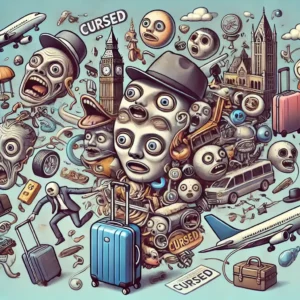The term “Totally Wackadoodle NYT” captures the essence of bizarre, unexpected, and downright eccentric stories that have graced the pages of The New York Times. Over the years, these tales have entertained and intrigued readers by showcasing the unusual side of human history and behavior. But what exactly makes these stories so fascinating? In this article, we will explore the origins of this concept, its evolution, and why it continues to capture readers’ imaginations.
Origins and Evolution of the Totally Wackadoodle Section
The concept of the Totally Wackadoodle NYT emerged as a way to bring together stories that defy logic and expectation. Initially, these stories might not have fit into traditional news categories. Instead, they found a place within this collection of oddities, which soon grew in popularity. The goal was simple: to entertain readers while offering a unique lens through which to view history and human behavior.
Over time, this section has evolved to include not just bizarre historical events but also satirical takes on current happenings, highlighting the oddities that make life unpredictable and, quite frankly, wackadoodle.
Real vs. Fictional: Uncovering the Truth Behind the Wackadoodle Stories
When diving into the Totally Wackadoodle NYT archives, one question often arises: are these stories real or fictional? The answer is a mix of both. Some stories are based on historical events that genuinely occurred, while others are exaggerated accounts or speculative narratives designed to spark the reader’s curiosity.
For example, while stories like “The Great Submarine Hoax” are rooted in real events, others might have a tinge of fabrication or dramatization. The magic of these tales lies in their ability to blur the lines between reality and fiction, keeping readers questioning and engaged.
Impact of Totally Wackadoodle Stories on Readers and Society
One of the reasons the Totally Wackadoodle NYT stories have become so popular is their ability to impact readers emotionally and intellectually. These stories invite readers to explore a side of history that is not found in textbooks—one filled with quirks, surprises, and humor.
Stories like “The Man Who Lived in a Tree” or “The Mystery of the Exploding Toads” offer a glimpse into human eccentricity and nature’s oddities, making readers reflect on how little we truly understand about the world. They provide a break from traditional news, offering a refreshing and lighthearted perspective that readers find irresistible.
The Most Memorable Wackadoodle Stories in NYT History
The Great Submarine Hoax of 1917
In 1917, during the tense atmosphere of World War I, the New York Times reported on a German submarine that supposedly surfaced off Long Island’s coast. The crew allegedly demanded supplies from local fishermen before disappearing. As it turned out, this incident was a hoax perpetrated by the fishermen themselves, playing into the public’s fears and imagination at the time.
The Case of the Disappearing Hotel Room
Another bizarre tale is that of a woman in 1899 who checked into a Paris hotel, only to find her room missing when she returned. The hotel staff denied any knowledge of her stay, leading to a mystery that remains unsolved. This story taps into our fascination with the unexplained and is one of the most perplexing stories in the Totally Wackadoodle NYT collection.
The Great Emu War
An unexpected and humorous chapter in Australia’s history saw the military engaging in a “war” against emus—a large, flightless bird. The outcome? The emus won. This peculiar event, covered by the New York Times, shows just how unpredictable and wackadoodle history can be.
Expert Insights: Why These Stories Resonate with Us
So, why do these stories stick with us? According to Dr. James Smith, a historian specializing in unusual historical events, “The Totally Wackadoodle NYT stories resonate because they remind us that life doesn’t always follow a predictable script. They tap into our natural curiosity and challenge our perceptions of what is normal or expected.”
It’s this unpredictability that draws readers in. We’re naturally curious about what lies beyond the mundane, and these stories provide a window into the odd and unknown.
Cultural Significance: Why We Love the Wackadoodle
Our fascination with these stories speaks volumes about society’s love for the unexpected and the strange. From viral internet memes to blockbuster movies centered around quirky events, people are drawn to things that break the mold. The Totally Wackadoodle NYT section capitalizes on this desire by offering tales that are both absurd and thought-provoking.
As Dr. Emily Johnson, an expert in cultural studies, puts it, “Wackadoodle stories serve as a cultural mirror, reflecting our fascination with the extraordinary and our willingness to embrace the oddities of life. They allow us to explore the limits of normality and expand our understanding of the world.”
Exploring the Archives: Tips for Finding More Wackadoodle Gems
Want to dive into the Totally Wackadoodle NYT archives yourself? Here are some tips:
- Start with Specific Eras: Choose a time period that interests you, like the Roaring Twenties or World War I, to find stories that fit that era’s unique cultural and social atmosphere.
- Use Playful Keywords: Words like “unbelievable,” “bizarre,” “strange,” and “unexplained” can help you uncover hidden gems in the archives.
- Read Beyond the Headlines: Sometimes, the full story isn’t clear from the headline alone. Dive into the articles to uncover the true wackadoodle nature of the story.
Future Directions: The Next Wave of Totally Wackadoodle Stories
As journalism evolves with technology, so too will the Totally Wackadoodle NYT section. In the digital age, we can expect more user-generated content, AI-generated stories, and even collaborations with digital artists to bring these bizarre tales to life in new and creative ways.
AI-Generated Wackadoodle Stories
With the rise of artificial intelligence, there’s potential for wackadoodle stories to take on a futuristic twist. Imagine AI writing headlines like “Time-Traveling Llamas Sue Over Trademark Infringement” or “Martian Barista Serves Cosmic Lattes to Astronauts.”
Quantum Quirkiness and Beyond
Quantum physics meets journalism in the future of Totally Wackadoodle NYT. We might read stories like “Schrödinger’s Cat Starts Its Own Blog” or “Parallel Universe Humans Vote for Dancing Pineapples.”
Conclusion: Embracing the Delightfully Odd Side of Journalism
The Totally Wackadoodle NYT section reminds us that history and journalism aren’t just about facts and data—they’re about the human experience in all its unpredictable and quirky glory. By exploring these strange archives, we not only entertain ourselves but also gain a deeper understanding of the past and what it means to be human.
Ready to explore the wackadoodle side of history? Dive into the Totally Wackadoodle NYT archives and see where the oddities take you!

















